Abstract
We report here the topics discussed during the round table of the 2nd European Conference & Practical Course: Towards Clinical Gene Therapy: Preclinical Gene Transfer Assessment, held in Bellaterra (Spain), 1–14 February, 2004. First, how to predict the risk of pathologies generated by changes of the gene expression after proviral genome integration. In the light of the scientific information that emerged after the SAEs occurred in three X-SCID patients treated in France, (a) it is necessary to take into the account the dose of vector used in transduction protocols, in order to minimize the risk to target potentially pathogenic loci. Namely, low vector doses are recommended to minimize the number of vector genomes inserted per cell. (b) The potency of vector elements (ie promoter and transgene), in terms of activation of undesired cell function(s), should be elucidated to devise safe transduction protocols. (c) Target cells should be better characterized before and after transduction to avoid reinfusion into patients' cells, with proviral integration that may be pathogenic. (d) The possibility of replacing onco-retroviruses with other vector systems should be envisaged, for example, nonintegrative gene correction strategies. Second, adequate animal models are required in preclinical experimentation before going to clinics. Although animal models are not yet predictive for risk assessment of proviral insertion, they allow validation of the proof of principle of gene therapy strategies and pharmacological characterization of gene transfer products. Third, a dialogue between researchers and members of regulatory agencies is necessary to implement the regulatory frame where gene therapy products are to be used as new bio-pharmaceuticals. This will implement the whole gene therapy process development at both preclinic (research, development and clinical designs) and postclinic (follow-up of patients) stages. Hence, a European cooperation between professionals (researchers, physicians, industries, patients' associations, investors, etc) will allow implementation of gene therapy regulation in Eastern European countries.
This is a preview of subscription content, access via your institution
Access options
Subscribe to this journal
Receive 12 print issues and online access
$259.00 per year
only $21.58 per issue
Buy this article
- Purchase on Springer Link
- Instant access to full article PDF
Prices may be subject to local taxes which are calculated during checkout



Similar content being viewed by others
References
Cavazzana-Calvo M et al. The future of gene therapy. Nature 2004; 427: 779–781.
(Pdf document available at http://www.emea.eu.int/pdfs/human/genetherapy/2288003en.pdf).
Schroder AR et al. HIV-1 integration in the human genome favors active genes and local hotspots. Cell 2002; 110: 521–529.
Wu X et al. Transcription start regions in the human genome are favored targets for MLV integration. Science 2003; 300: 1749–1751.
Hacein-Bei S et al. LMO2-associated clonal T cell proliferation in two patients after gene therapy for SCID-X1. Science 2003; 302: 415–419.
Baum C et al. Chance or necessity? Insertional mutagenesis in gene therapy and its consequences. Mol. Ther 2004; 9: 5–13.
Fehse B et al. Pois(s)on – it's question of dose. Gene Therapy 2004; 11: 879–881.
Recchia A et al. Site-specific integration of functional transgenes into the human genome by adeno/AAV hybrid vectors. Mol Ther 2004; 10: 660–670.
Krahn M et al. Efficient transduction of human cord blood and adult peripheral blood CD34+ progenitors with HSV-1 deived amplicon vectors. Gene Therapy 2004; 11 (S1): S123.
Papapetrou EP, Zoumbos NC . A Athanassiadou A Genetic modification of hematopoietic stem cells with non-viral systems: past progress and future prospects. Gene Therapy 2005; 12 (Suppl 1): S118–S130 (this issue).
Soudais C et al. Stable and functional lymphoid reconstitution of common cytokine receptor gamma chain deficient mice by retroviral-mediated gene transfer. Blood 2000; 95: 3071–3077.
Press release on 9/06/2004 at http://afssaps.sante.fr/htm/10/filcopr/040603.htm (document in French).
Israeli D et al. A proposal for the physiological significance of mdr1 and Bcrp1/Abcg2 gene expression in normal tissue regeneration and after cancer therapy. J Theor Biol 2005; 232: 41–45.
Goyenvalle A et al. Rescue of dystrophic muscle through U7 snRNA-mediated exon skipping. Science 2004; 306: 1796–1799.
Shelton GD, Engvall E . Canine and feline models of human inherited muscle diseases. Neuromusc Disord 2005; 15: 127–138.
Ross G et al. Gene therapy in the United States: a five-year status report. Hum Gene Ther 1996; 7: 1781–1790.
Edelstein ML, Abedi MR, Wixon J, Edelstein RM . Gene therapy clinical trials worldwide 1989–2004. J Gene Med 2004; 6: 597–602.
Acknowledgements
We thank all participants to the second European Conference and Course held in Bellaterra, who animated the round table discussion and Drs K Cichutek (Langen) and D Caizergues (Evry) for the critical reading of the manuscript.
Author information
Authors and Affiliations
Rights and permissions
About this article
Cite this article
Gonin, P., Buchholz, C., Pallardy, M. et al. Gene therapy bio-safety: scientific and regulatory issues. Gene Ther 12 (Suppl 1), S146–S152 (2005). https://doi.org/10.1038/sj.gt.3302629
Published:
Issue Date:
DOI: https://doi.org/10.1038/sj.gt.3302629
Keywords
This article is cited by
-
Intratympanic Gene Delivery of Antimicrobial Molecules in Otitis Media
Current Allergy and Asthma Reports (2015)
-
Electro-Acupuncture Promotes the Survival and Differentiation of Transplanted Bone Marrow Mesenchymal Stem Cells Pre-Induced with Neurotrophin-3 and Retinoic Acid in Gelatin Sponge Scaffold after Rat Spinal Cord Transection
Stem Cell Reviews and Reports (2014)
-
Modulation of cellular behavior by exogenous messenger RNA
Leukemia (2006)



